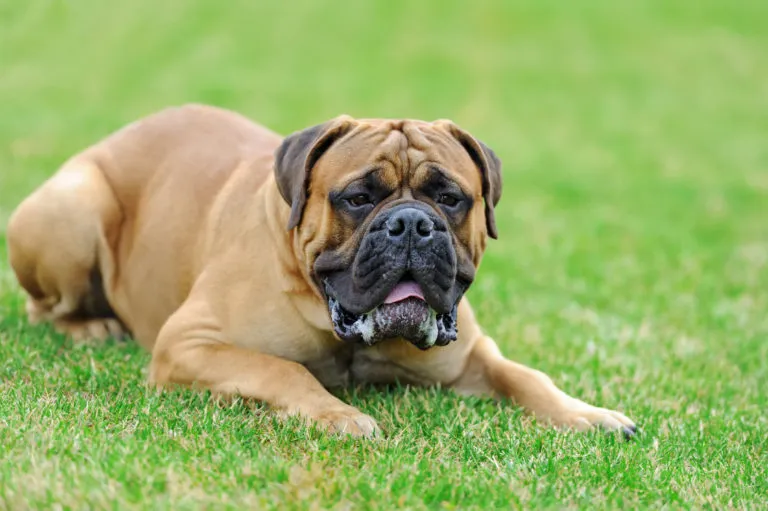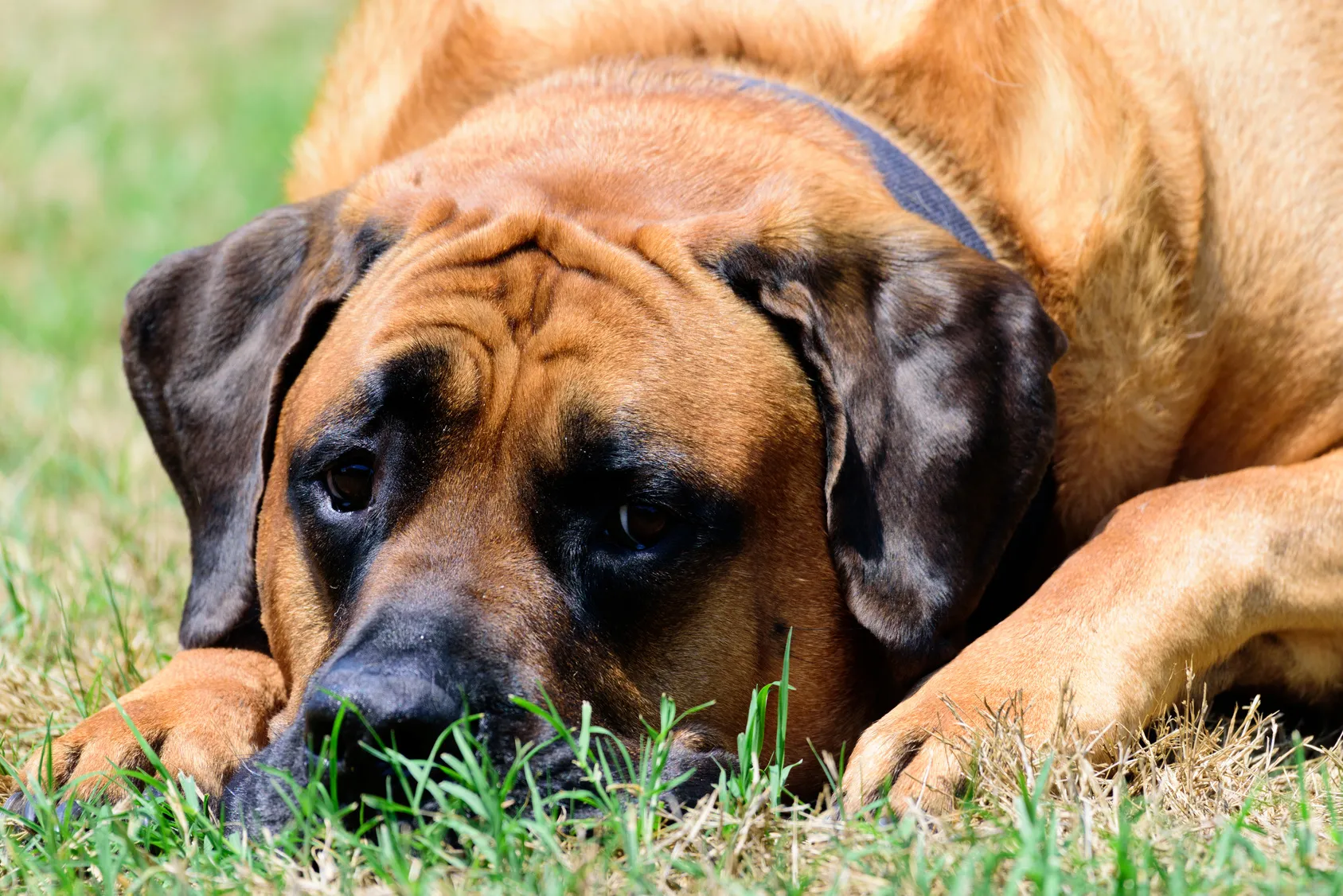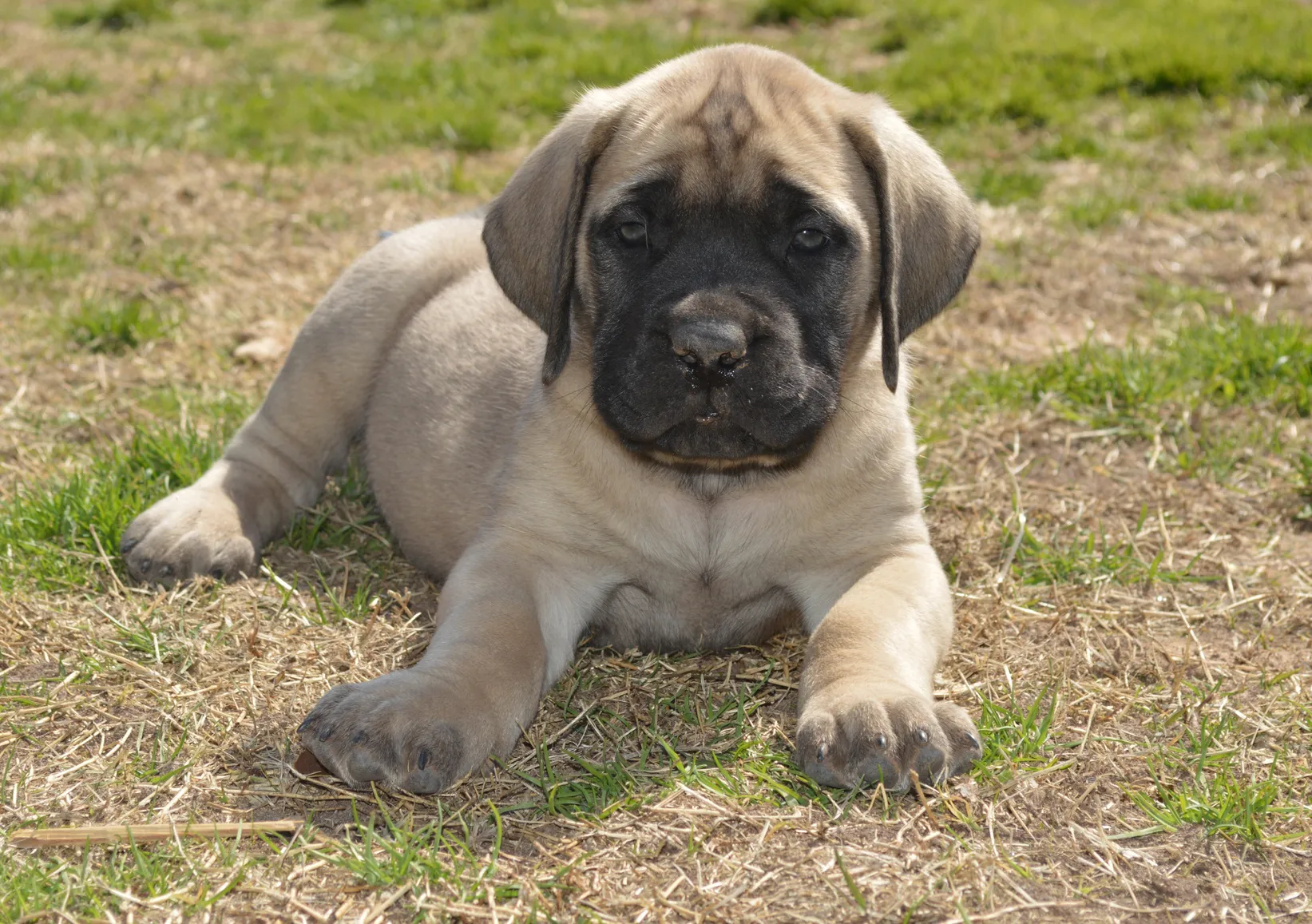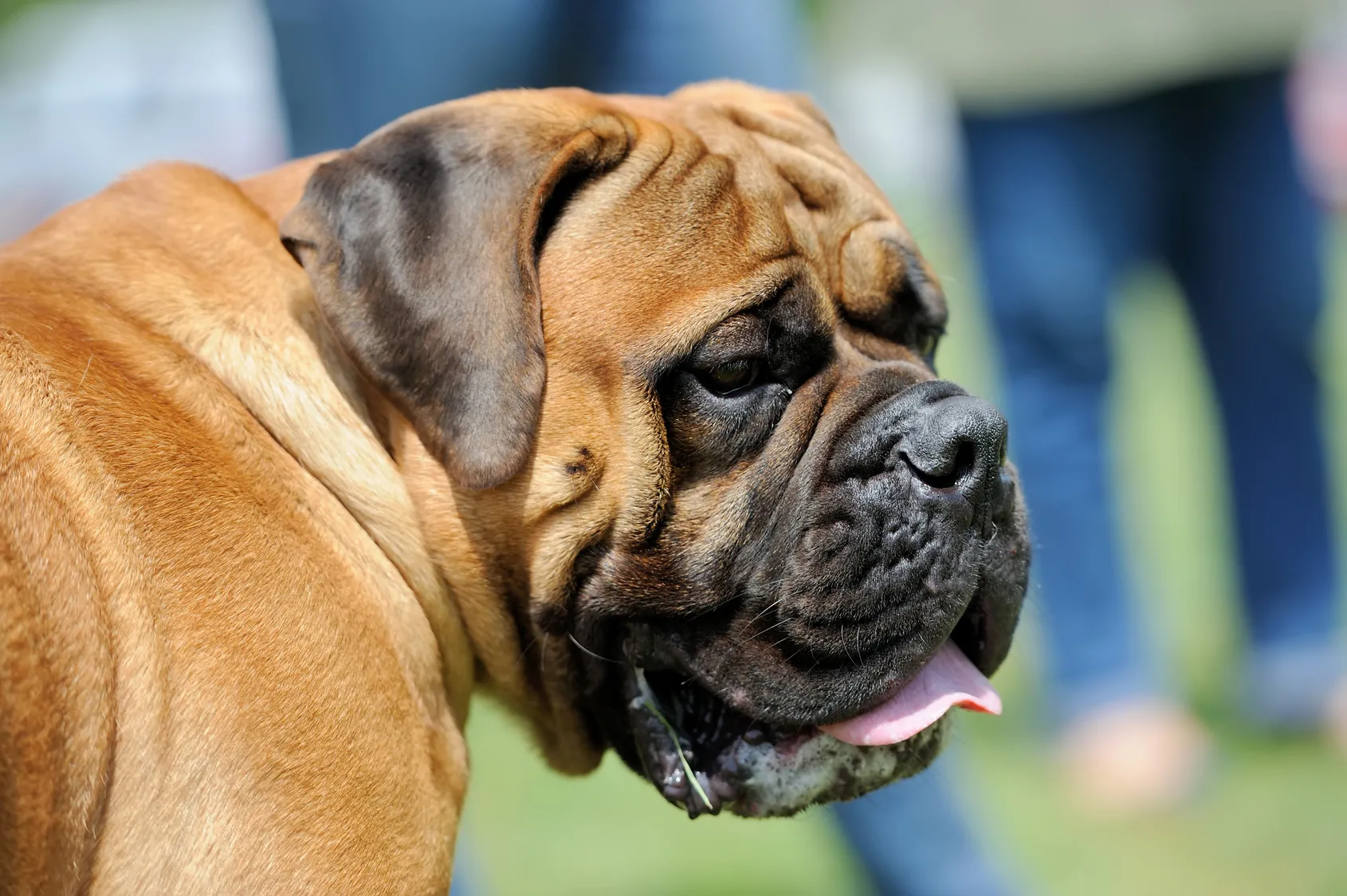Beagle
The Beagle's short legs can be deceiving – this medium-sized dog keeps you on your toes and is always full of surprises! This friendly breed is active, fearless and extremely clever.
Strength lies in peace: Despite its immense bodily strength, the Mastiff's real strength is in its calm, tranquil nature, not its muscles. This massive dog monitors situations closely and prefers to wait before reacting to changes. Impulsive or aggressive behaviour is totally alien to this gentle giant.

© byrdyak / stock.adobe.com
The English Mastiff is characterised by its incredibly high sensitivity threshold. Noise, stress or other animals don’t make these tranquil canines lose their cool. This enviable composure, calm reserve and high sensitivity has given the Mastiff the epithet gentle giant in Britain, its country of origin, making it both a superb family dog and a successful therapy dog too.
In contrast to their forefathers, who stood out in ancient arenas as a result of their fearless battles with bears or bulls, the modern English Mastiff shows hardly any aggressive traits. Contrary to the assumption of some non-specialists who confuse the dog’s reserved nature with fearfulness, Mastiffs remain to this day very brave dogs. In situations where they perceive a serious threat to their loved ones’ safety, these large, strong dogs wouldn’t hesitate to set upon the aggressor, but they would remain in control at all times and would only actually attack and seriously injure the aggressor in cases of dire emergency. This combination of a formidable appearance, strong nerves and level-headed approach makes the Bullmastiff almost predestined for its role as a guard dog, which it still regularly assumes in its homeland Britain. In Germany, this rare-to-find dog breed is prized above all as a good-natured and friendly family dog. Mastiffs are very closely drawn to their families and even their huge bodily weight and size doesn’t hold them back when it comes to abundant cuddles and snuggles with their loved ones. Thanks to their highly people-oriented character, Mastiffs are incredibly easy to train and generally do everything they can to please their owners. However, these intelligent dogs are known to have a certain independence of mind, so you can’t expect total obedience from them. This disobedience never results in defiant or aggressive behaviour though, so it shouldn’t prove problematic for the owner. Due to their unshakeable composure and love of people, living with an English Mastiff is a very harmonious experience. When dealing with small children or elderly people, they are highly empathetic playmates and companions. They also show remarkable tolerance towards other dogs and animals. The good-natured Mastiff is always calm but nevertheless distant when faced with strangers. It’s clear the Mastiff is very much in control when it comes to matters of love too, preferring to observe first and properly assess people before giving them its love.
 © Thomas Foldes / stock.adobe.com
© Thomas Foldes / stock.adobe.com
Despite its good-natured and loving character, the Mastiff is on the breed list in some German states (and in other European countries), which means that keeping one is only permitted in compliance with certain rules and regulations. This is influenced more by its imposing appearance than its actual character, with “potential for danger” assumed exclusively from its size and associated strength. There’s no question that the powerful skull with its wide jaw demands respect. There’s no need to fear the Bullmastiff, but an overconfident leap in the air can certainly have unwanted consequences. Hence, there’s no doubt that loving and consistent training is required along with comprehensive socialisation in order to teach this huge dog to appreciate its strength and apply it in just the right measure.
Up to 90cm in height and 100kg in weight, the Mastiff is ultimately one of the largest and heaviest dogs in the world. In November 1989, the male Mastiff Aicama Zorba La-Susa reached a height of 95cm and a weight of 155.58kg, making it the world’s heaviest dog according to the “Guinness Book of Records”.
The Mastiff is listed under number 264 (group 2, section 2: Molosser breeds) of the FCI’s breed standard, which indicates no exact weight for the dog breed. However, a large size is clearly desirable as long as it doesn’t affect the dog’s health. According to the standard, size and weight should be “well balanced”. This dog’s large, bulky body has to be well proportioned and by no means obese. The ideal Mastiff is large, bulky, strong and well proportioned, conveying a harmonious and consolidated overall image.
The Mastiff’s short, flat fur lies close to the body and makes the muscles appear more plastic. The sagging flews, highly set ears and the chin that wrinkles as a sign of concentration gives the Mastiff’s wide skull its characteristic square look. The highly muscular throat is almost equal in size to the head and further accentuates the bulky appearance.
The Mastiff can be found in the colours apricot, dun or blotched. Dark markings on the nose, snout and ears are highly desirable, forming the mask typical of the Mastiff. In contrast, an excessive amount of white spots on the body, chest or feet are not accepted.
 © Jennifer / stock.adobe.com
© Jennifer / stock.adobe.com
Along with other external features, the Mastiff’s colour has historically been a source of disagreement amongst experts. This likely has something to do with the fact that it has still not been possible to clarify the origin of the Mastiff to this day.
In the days of the Roman Empire, heavy dogs very similar to today’s Mastiff type at least in terms of appearance served as fight dogs and war dogs. The Celts and Normans must ultimately have brought them to Britain, the homeland of the Mastiff dog breed. Another theory states that the Mastiff is a direct descendant of the Molosser, which came to Britain from Epirus and Macedonia on merchant ships. Still, others claim that the Mastiff on the other hand descends from the Tibetan Mastiff. Earlier sources see the Mastiff as an autonomous dog breed, meaning that the breed developed in an entirely natural manner without human involvement in targeted breeding. At the least, the connection to the Tibetan Mastiff was largely disproved in the meantime.
Even though the history of the Mastiff’s forefathers in ancient times cannot be fully clarified, the development of the breed can be traced from at least the Middle Ages. The Mastiff is named for the first time in the 14th century in a discourse by Edmund of Langley, the first Duke of York. However, here it must be mentioned that all massive dogs in England with wide mouths and square-shaped skulls were originally called Mastiffs. It is clear though that Mastiff dogs were diversely established in the Middle Age, especially in Great Britain. They are referred to as war dogs, guard dogs, hunting dogs and fight dogs. The first evidence of a Mastiff as a war dog is found in the account of the Battle of Azincourt in 1415, where one of these huge dogs loyally accompanied its severely wounded master and protected him from further enemy attacks. These powerful dogs were popular amongst the upper classes as hunting dogs for chasing bears or wild boars. In the Middle Ages, they were above all deployed for the people’s entertainment in publicly held bear or bullfights. In the 16th century, specially-designed arenas emerged in the area surrounding London. During so-called bear and bull baiting, Mastiffs (and other large dogs) had to line up against bears, lions, bulls and other predators. The brutal occupation of fight dog was only stopped in 1835 when the British government finally brought itself to impose a ban on these bloody spectacles.
Around the same time, pure breeding of the Old English Mastiff commenced in Britain. In 1872, the first Mastiff Club was founded and deliberate crossing with flat-haired St Bernard’s took place, which ensured the Mastiff’s character became gentler and more tranquil.
However, this did not change the fact that the Mastiff disappeared more and more from scene following the ban on animal combat. During both World Wars there was a threat of almost complete extinction, since hardly anybody was able to provide enough food for these huge dogs during the tough war years. Thanks to support from Canada and the USA, where a few specimens survived, the breed could be started up again in Britain after the end of the war.
The Old English Mastiff is now not just one of the largest and oldest dog breeds in the world, but the breed of origin for a whole range of different breeds such as the Great Dane, Newfoundland, Bullmastiff and St Bernard. In contrast to its relatives though, the Mastiff is now a very rarely-found breed of dog (apart from in its homeland Britain).
The size alone is surely enough to scare some dog lovers off acquiring a Mastiff. After all, such a large dog needs both lots of space and food in abundance. At least the time spent grooming a Mastiff is very low. Simply brushing the smooth, short fur is sufficient to keep it clean – and the Mastiff enjoys this special attention to the full.
The dog’s skin folds require special attention, since they can easily end up embedded with parasites and dirt. Carrying out regular check-ups and cleansing is imperative in order to avoid infections.
Besides this, the Mastiff is a very robust dog breed with few breed-specific hereditary diseases. Nevertheless, some Mastiffs suffer from hip joint problems (HD), as can be the case with other dogs of their size. Heart disease can also occur in isolated cases.
Furthermore, Mastiffs have a tendency to end up with a bloated stomach. In order to prevent this, it is better to offer several small food portions over the course of the day rather than one large meal. In general, well-balanced nutrition has a positive effect on the animal’s health, as is the case with us humans. Since Mastiffs already carry enough kilos, you must pay attention to make sure they don’t become overweight. This doesn’t just make them sluggish and ponderous, but also damages the bone structure and can lead to further health problems.
 © byrdyak / stock.adobe.com
© byrdyak / stock.adobe.com
Along with a healthy diet and regular check-ups at the vet, sufficient exercise is essential to keep the Mastiff in good health. A house with a large garden is ideal for keeping a dog of this size, as they need space to let off steam at will. This of course doesn’t replace daily walks though.
The most important thing for a Mastiff is definitely being close to its loved ones. These devoted dogs always want to be involved and are in no way suited for being housed in a kennel.
Mastiffs need a lot of affection, so their owner should always behave in a calm and loving manner during training and give a great deal of praise. Shouting loud orders seriously frightens these harmonious dogs. Despite their good-natured and people-focused nature, they do need consistent training that makes it clear what is expected of them. It’s important to ensure goals are clearly defined from the very start, as inconsistent training confuses the Mastiff.
Comprehensive socialisation in the puppy stage also helps to encourage the Mastiff’s composed nature. Hence, as the buyer you should ensure that young Mastiffs quickly come into contact with other cats and dogs, children, joggers and cyclists. The greater their range of experiences as a puppy, the less they will later be fearful and react in an unexpected manner.
A well-trained and socialised Mastiff definitely has an uncomplicated attitude in spite of its size. Its unwavering composure, love of children and peaceful protective instinct makes it both a suitable guard and therapy dog and a loyal family dog with a huge heart.
The Beagle's short legs can be deceiving – this medium-sized dog keeps you on your toes and is always full of surprises! This friendly breed is active, fearless and extremely clever.
The Golden Retriever is still one of the most popular dog breeds, especially with families. It is defined not just by its docility, but shows numerous other qualities too. Read in the following article everything you need to know about the Golden Retriever.
The German Shepherd is one of the most popular utility dog breeds in the world, though the willing-to-learn and people-focused nature of these versatile dogs also makes them suitable for family life.